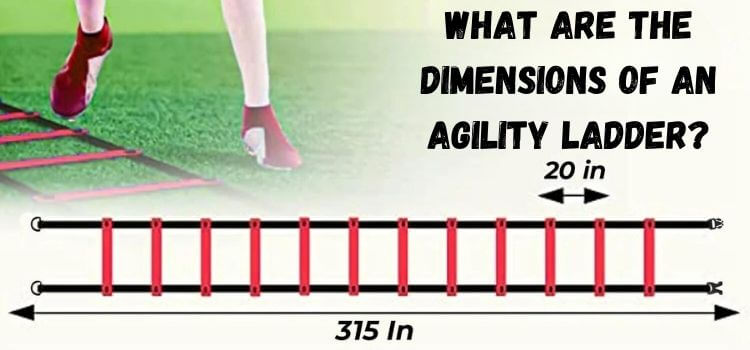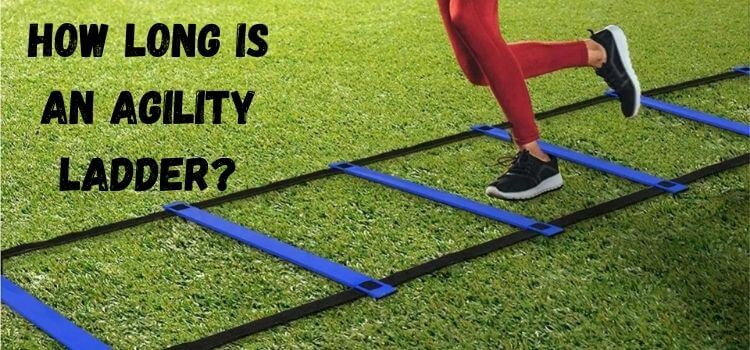As an Amazon Associate, I earn from qualifying purchases
Agility training has become an integral part of fitness routines for athletes, fitness enthusiasts, and even individuals looking to enhance their overall physical prowess. Among the various tools used for agility training, agility ladders stand out as one of the most versatile and practical. But what are the dimensions of an agility ladder, and why are they important?

Introduction to Agility Ladders
Agility ladders, also known as speed ladders or footwork ladders, are portable training tools used to improve agility, speed, coordination, and footwork.
Athletes can walk or hop through them in different patterns and sequences. They are made up of a set of rungs or steps that are spaced apart.
Importance of Agility Training
Before delving into the dimensions of agility ladders, it’s crucial to understand the significance of agility training. The capacity for swift movement and effortless direction changes is known as agility.
It plays a vital role in numerous sports and activities, including football, basketball, soccer, martial arts, and even everyday movements.
Components of an Agility Ladder
To comprehend the dimensions of an agility ladder, we must first understand its essential components:
Length
The length of an agility ladder refers to the overall distance from one end to the other. It determines the area it covers during training sessions.
Width
The width of an agility ladder signifies the lateral distance between the two parallel sides. It influences the space available for footwork drills.
Rung Spacing
Rung spacing refers to the distance between each rung or step of the ladder. It determines the challenge level and intensity of the exercises.
Standard Dimensions of Agility Ladders
Agility ladders come in various sizes, but there are standard dimensions commonly used in training:
Width of Agility Ladders
The standard width of an agility ladder ranges from 16 to 20 inches. This width provides enough space for athletes to perform quick foot movements without stepping out of bounds.
Length of Agility Ladders
Agility ladders typically measure between 15 to 30 feet in length. The longer the ladder, the more diverse the training possibilities, allowing athletes to perform extended sequences and drills.
Rung Spacing of Agility Ladders
The optimal rung spacing of an agility ladder is around 15 to 18 inches. This spacing challenges agility and coordination without compromising safety.
Types of Agility Ladders
Agility ladders come in various types, including flat-rung ladders, elevated-rung ladders, and adjustable ladders. For a variety of training requirements, each variety provides unique characteristics and advantages.
Benefits of Using the Correct Dimensions
Using agility ladders with the correct dimensions offers several benefits:
- Improved foot speed and coordination
- Enhanced agility and balance
- Increased cardiovascular endurance
- Injury prevention through better movement mechanics
How to Choose the Right Agility Ladder
When selecting an agility ladder, consider factors such as your training goals, available space, and budget. Ensure the ladder’s dimensions align with your specific needs and skill level.
Exercises with Agility Ladders
Some countless exercises and drills can be performed with agility ladders, including:
- Two-feet forward run
- Lateral shuffle
- In-and-out drill
- Ickey shuffle
- 180-degree jump turn
Maintenance and Care Tips
To prolong the lifespan of your agility ladder, follow these maintenance tips:
- After every usage, clean the ladder to get rid of dirt and debris.
- To avoid damage and rust, store it indoors in a dry area.
- Avoid stepping on the rungs with shoes that have metal spikes or cleats.
Conclusion
In conclusion, understanding the dimensions of an agility ladder is crucial for practical training and optimal performance. By choosing the right size and spacing, athletes can maximize their agility training results and elevate their athletic abilities.
FAQs (Frequently Asked Questions)
Yes, agility ladders can be adjusted to accommodate individuals of all skill levels, including beginners.
Absolutely! Regular agility ladder training can significantly enhance your speed, agility, and overall athletic performance.
Aim to include agility ladder drills at least two to three times per week for optimal results.
Yes, agility ladder training improves balance, coordination, and proprioception, which can reduce the risk of injury during sports and physical activities.
No, as long as exercises are done carefully and within a person’s physical limitations, agility ladders are appropriate for people of all ages, from young children to elderly seniors.
Read Our More Articles
- How to Make an Agility Ladder with Tape: A Comprehensive Tutorial
- How to Untangle Agility Ladder: Quick Tips for Easy Setup
- How Wide is an Agility Ladder? A Beginner’s Guide
As an Amazon Associate, I earn from qualifying purchases


